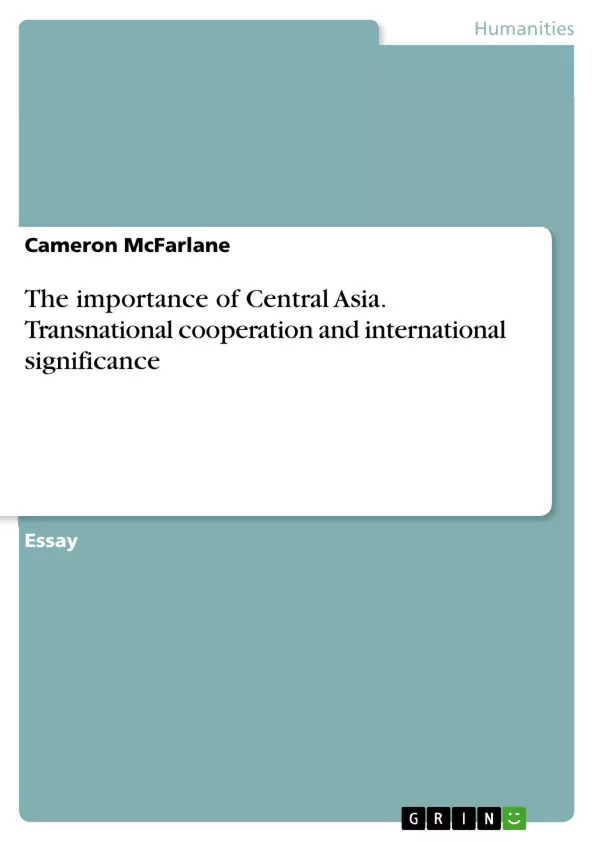This essay strives to give the reader an extensive understanding of Central Asia, particularly focusing on the cooperation in Central Asia and the importance of the region internationally. This essay will focus on the main features of cooperation in Central Asia, considering predominantly the main features of the Shanghai Cooperation Organization which embodies four states in Central Asia, the Russia Federation and the People's Republic of China (PRC). Furthermore, in examining the importance of the region, this essay will primarily focus on the significance of the region for the two neighbouring regional powers – Russia and the PRC.
Since the collapse of the Soviet Union in 1991, Central Asia, which comprises of Kazakhstan, Kyrgyzstan, Tajikistan, Turkmenistan, and Uzbekistan, has had to form bilateral and multinational relations, including the establishment of diplomatic ties. Central Asia’s landlocked location puts it at the heart of Eurasia, neighbouring regional powers, Russia and China, and in close proximity with other potential regional powers, Iran, and India, however, also surrounded by the regions of South Asia, South-East Asia, the Middle East, and Europe.
Inhaltsverzeichnis (Table of Contents)
- The Importance of Central Asia
- The Shanghai Cooperation Organization
- Central Asia: A Vital Region
- Threats to the Region
- Regional Cooperation and Integration
- Conclusion
Zielsetzung und Themenschwerpunkte (Objectives and Key Themes)
This essay aims to provide a comprehensive understanding of Central Asia, focusing on regional cooperation and its international significance. It delves into the features of cooperation in the region, particularly within the Shanghai Cooperation Organization, and examines the strategic importance of Central Asia for regional powers like Russia and China, as well as for the United States.
- Cooperation in Central Asia
- The role of the Shanghai Cooperation Organization
- Central Asia's strategic importance for regional powers
- Internal threats to stability in Central Asia
- The need for regional cooperation and integration
Zusammenfassung der Kapitel (Chapter Summaries)
The first chapter provides an overview of the Central Asian region, outlining its historical significance and geopolitical location. It also highlights the challenges faced by the region since the collapse of the Soviet Union, including ethnic disputes and nation-building. The second chapter focuses on the Shanghai Cooperation Organization, its formation, goals, and impact on regional cooperation. It discusses the organization's role in security, economic cooperation, and cultural exchange. The third chapter examines the strategic significance of Central Asia for major powers, particularly Russia, China, and the United States. It explores their interests in the region, including energy resources, trade routes, and geopolitical influence. The fourth chapter delves into the threats to the region's stability, highlighting internal sources of instability such as terrorism, religious extremism, and ethnic conflicts. The fifth chapter emphasizes the importance of regional cooperation and integration for addressing these threats and achieving sustainable development in Central Asia.
Schlüsselwörter (Keywords)
This essay focuses on Central Asia, regional cooperation, the Shanghai Cooperation Organization, strategic importance, regional powers, Russia, China, the United States, internal threats, terrorism, extremism, and regional integration.
- Arbeit zitieren
- BBus BIntSt Cameron McFarlane (Autor:in), 2013, The importance of Central Asia. Transnational cooperation and international significance, München, GRIN Verlag, https://www.hausarbeiten.de/document/345070


